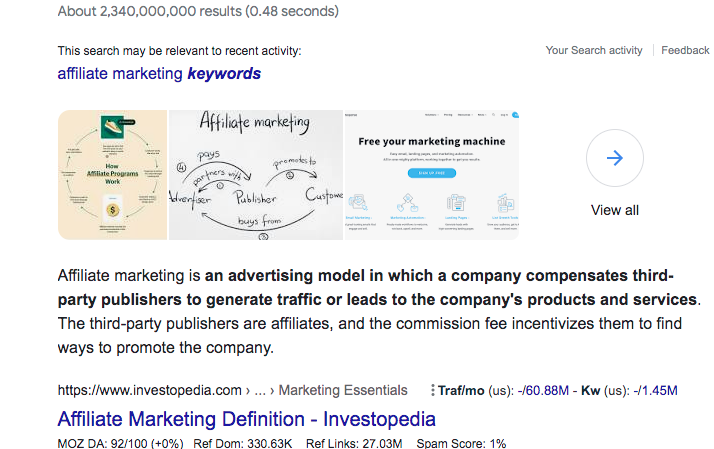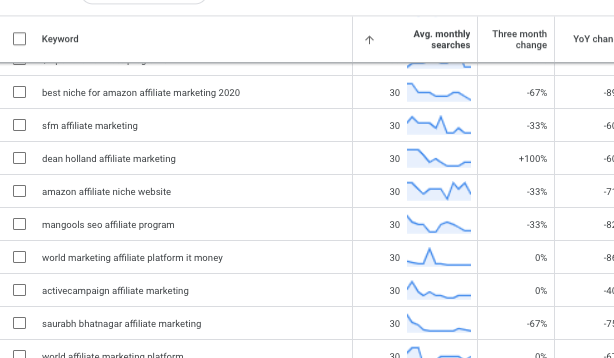Short tail and long tail keywords offer different opportunities for bloggers and content creators. Short tail keywords have a higher volume of search traffic but it’s much more difficult ranking your content for them. An example of a short tail keyword might be “affiliate marketing” for example. If we look at Google’s keyword planner for the monthly search volume of this keyword, we will find a huge amount of traffic.

In fact it’s 673,000 monthly searches for this particular short tail keyword. The year on year change (YoY change) is +22% which means the search traffic is growing yearly!
Having your website rank at the top for this keyword would be fantastic because of all the free traffic you would get. However, doing this would be incredibly difficult. Let’s have a look at the pages which rank on page 1 of Google for the term “affiliate marketing”.

The top three results are investopedia.com, blog.hubspot.com and neilpatel.com; three incredibly high authority websites. If you look at the number at the top too, you’ll see it’s 2,340,000,000 which denotes the amount of competition for this domain name. A closer look can be done with inverted commas around the keyword on Google like so “affiliate marketing”. The number which shows denotes the competing web pages for this search phrase.

Wow: 56,900,000 pages competing for this phrase. So ranking your website for this phrase will be pretty difficult if not impossible. The websites which rank for this phrase have hundreds of thousands of back links, high authority and have been around for years if not decades. So it’s not a good idea to try and rank your content for such a highly competitive and short tail keyword. There’s simply too much competition.
Short Tail And Long Tail Keywords – Finding Long Tail Keywords
This is why many bloggers and content marketers who use organic search for their traffic target longer tail keywords with their content. Instead of targeting “affiliate marketing” for example with your content, you can find longer tail keywords with low SEO difficulty. This can be done with Google’s keyword planner.
Click the header in the column (in Google’s keyword planner) which denotes average monthly searches until the search volume drops. You will see the keywords change like so:

Longer tail keywords generally offer lower search volume and you can see for example the keyword for “best niche for amazon affiliate marketing 2020” only gets 30 searches a month. Despite this being a much lower volume than the term “affiliate marketing”, you will have much fewer competing websites for this search term. Because of this, you have a much better chance of ranking your website content for that particular term if you create a blog post for it.
A small percentage of 30 searches a month, is far better than zero percentage of the 673,000 searches for the short tail keyword of “affiliate marketing”. If you try and rank content for “affiliate marketing”, you site has almost no chance of making it to the first page of Google. However, if you target the longer tail keywords, such as “best niche for amazon affiliate marketing 2020”, you have a stronger chance of getting your page to the first page of Google.
Short Term Vs Long Tail Keyword Phrases
Lets head over to Google and see how different this phrase is in terms of competing pages.

As you can see, “best niche for amazon affiliate marketing 2020” for a phrase match only shows 1090 competing pages. Here’s what the results show for a normal search of the term:

3,300,000 and 1090 are a lot lower numbers than the ones for the shorter tail keyword of “affiliate marketing” which were: 2,340,000,000 and 56,900,000 by comparison.
By aiming for the “low hanging fruit” bloggers and content creators can attract an audience to their content for free through the search engines. All they need to do is research which keywords will give them the best opportunity for ranking and bringing in the right audience for them to their website.
Of course some of the longer tail keyword phrases won’t have the right kind of search intent for your website. So you’ll want to find the long tail keywords which offer less competition and which also bring the right kind of traffic to your website.
Search Intent & Your Offering
If you’re promoting affiliate products from your website, you want to attract an audience which is a good match for your offerings. Attracting the wrong audience, even if it’s for free isn’t a good idea. The wrong traffic to your site is much less likely to be buyer traffic.
So even though some long tail keywords will give you a chance to get free search traffic to your site, you also need to keep in mind the search intent of the person doing the search. For example, looking through the keyword planner at the longer tail keywords I can find a keyword here which may offer a good opportunity at first glance:

“Free traffic for clickbank products” might offer me the opportunity to rank for content based around this idea. However, do I really want people who are looking for free traffic and who are promoting Clickbank products? People who are seeking free stuff are much less likely to turn into buying customers.
Knowing your target audience is therefore useful when targeting long tail keywords with your content. See also how to know your target market and customer avatar worksheet pdf.
See also find long tail keywords with low